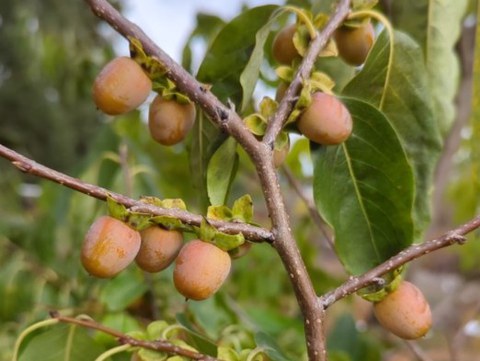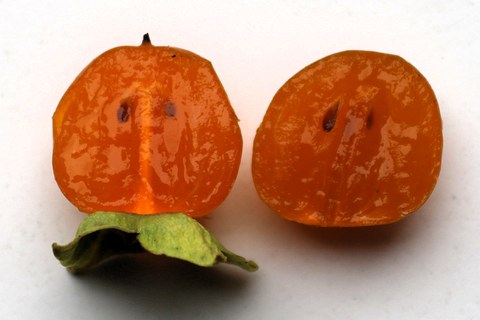03.11.2025
Unsere Pflanze der Woche: Die Lotuspflaume
Die Lotuspflaume Diospyros lotus L.
Unsere Pflanze der Woche ist ein Obstgehölz, das hierzulande recht unbekannt ist. Die Lotuspflaume Diospyros lotus L. besiedelt gemäßigte Gebiete von der Türkei bis Korea.
Die weiblichen Bäume der zweihäusigen Art tragen derzeit etwa weintraubengroße, orangefarbene, bereifte, süß schmeckende Beeren. Diese werden auch ohne männlichen Bestäubungspartner ausgebildet (Parthenokarpie). Vollreife und getrocknete Früchte lassen sich unbeschwert genießen. Frischobst, das noch nicht ganz ausgereift ist, enthält wasserlösliche Tannine, die mitunter ein pelziges, adstringierendes Mundgefühl hinterlassen.
Das Obst enthält viele wertvolle sekundäre Pflanzenstoffe - darunter Carotinoide, Mineralien, Vitamine und Ballaststoffe. Früchte und Samen werden auf verschiedene Weise volksmedizinisch genutzt. Dass Lotuspflaumen geschmacklich an Kakis (Diospyros kaki Thunb.) erinnern, verwundert nicht: Diese deutlich größere Frucht ist eine nahe Verwandte. Sie wird seit über 2000 Jahren im ostasiatischen Raum angebaut und zählt dort zu den ältesten Nutzpflanzen. Bei uns bietet der Handel meist die kernlose und gerbstoffarme Kaki-Sorte 'Sharon' an.
Neben den Obstlieferanten gehören zur fast 800 Arten umfassenden Gattung Diospyros auch einige holzliefernde Arten. Sie waren namensgebend für die Pflanzenfamilie der Ebenholzgewächse, zu denen die Gattung zählt. Tropische Ebenhölzer besitzen politische Sprengkraft, da sie eng mit Kolonialismus und transatlantischem Sklavenhandel verwoben sind.
Im Botanischen Garten Dresden können Interessierte noch zwei weitere Arten entdecken: Diospyros cauliflora Blume und Diospyros whyteana (Hiern) F.White gehören der tropischen Flora an und sind im Regenwaldhaus I zu finden.
(KW 45/25)
Etwa 10.000 Pflanzenarten wachsen im Botanischen Garten der TU Dresden. Auf dieser Seite stellen wir Ihnen regelmäßig ein Beispiel aus dieser Vielfalt näher vor. Die Besonderheiten unserer wissenschaftlichen Pflanzensammlung zeigen sich auf vielerlei Art und Weise: in erstaunlichen Anpassungen, wunderlichen Namen, einer interessanten Verwendung oder auch in einer außergewöhnlichen Blütenpracht.
Die bisherigen Beiträge zur Pflanze der Woche können Sie im Archiv einsehen.


